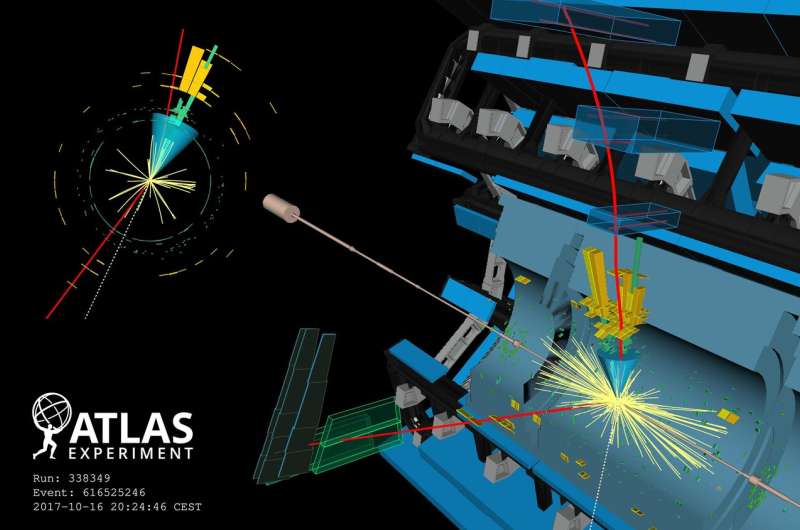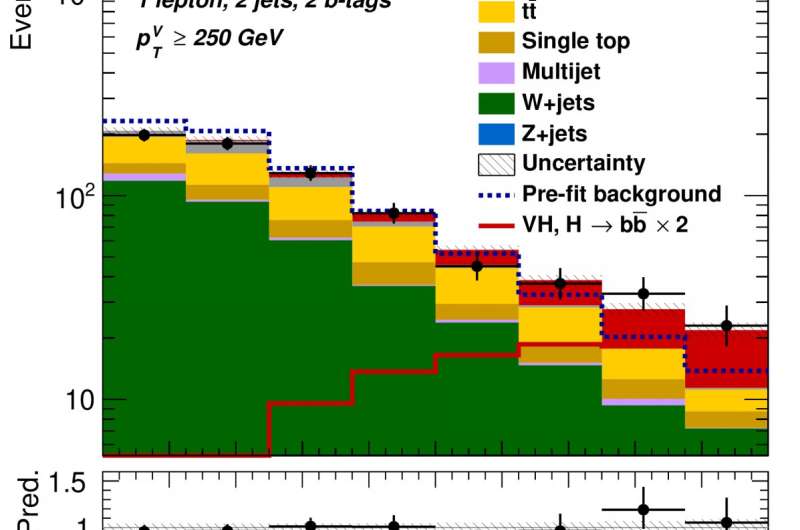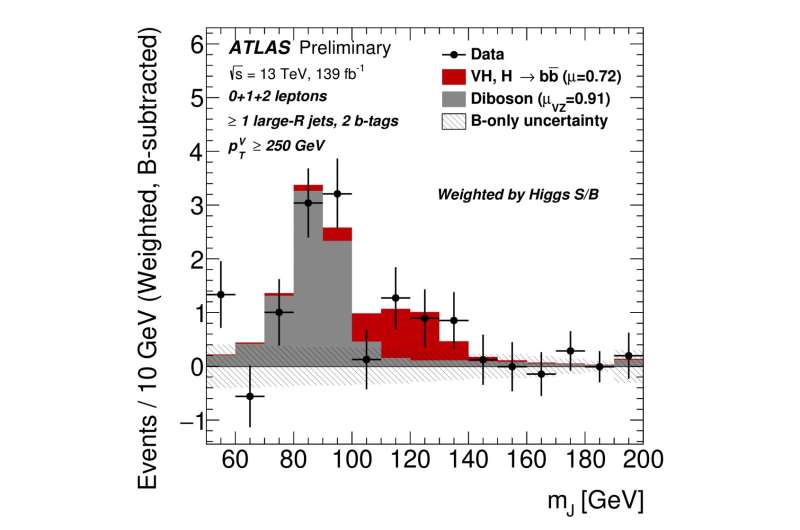ATLAS Experiment measures the 'beauty' of the Higgs boson

Two years ago, the Higgs boson was observed decaying to a pair of beauty quarks (H→bb), moving its study from the "discovery era" to the "measurement era." By measuring the properties of the Higgs boson and comparing them to theoretical predictions, physicists can better understand this unique particle, and in the process, search for deviations from predictions that would point to new physics processes beyond our current understanding of particle physics.
One such deviation could be the rate at which Higgs bosons are produced under particular conditions. The larger the transverse momentum of the Higgs boson—that is, the momentum of the Higgs boson perpendicular to the direction of the Large Hadron Collider (LHC) proton beams—the greater we believe is the sensitivity to new physics processes from heavy, yet unseen particles.
H→bb is the ideal search channel to search for such deviations in the production rate. As the most likely decay of the Higgs boson (accounting for ~58% of all Higgs-boson decays), its larger abundance allows physicists to probe further into the high-transverse-momentum regions, where the production rate decreases due to the composite structure of the colliding protons.
In new results released this month, the ATLAS Collaboration at CERN studied the full LHC Run 2 dataset to give an updated measurement of H→bb, where the Higgs boson is produced in association with a vector boson (W or Z). Among several new results, ATLAS reports the observation of Higgs-boson production in association with a Z boson with a significance of 5.3 standard deviations (σ), and evidence of production with a W boson with a significance of 4.0 σ.

The new analysis uses ~75% more data than the previous edition. Further, ATLAS physicists implemented several improvements including:
- Better Boosted Decision Tree (BDT) machine learning algorithms used to separate collisions containing a Higgs boson from those containing only background processes. Figure 2 shows the separation achieved between these processes by one of the BDTs.
- Updated selections used to identify collisions of interest enriched in the various background processes. These "control regions" allowed the physicists to gain a better understanding of and a handle on the background processes.
- Increased number of simulated collisions. Whilst crucial for predicting backgrounds in a measurement, simulating collisions throughout the ATLAS detector is a compute-intensive process. In this new analysis, teams throughout ATLAS made strong efforts to increase the number of simulated collisions by a factor of four compared to the previous analysis.

These improvements allowed ATLAS physicists to make more precise measurements of the Higgs-boson production rate at different transverse momenta, and to extend their reach to higher values.
ATLAS physicists also announced an extension to the H→bb study: a new version of the analysis designed to probe the Higgs boson when it is produced with very large transverse momenta. Normally, the two b-quarks from the H→bb decay manifest themselves in the ATLAS detector as two separate sprays of highly collimated and energetic particles, called "jets." However, when the Higgs boson is produced at very large transverse momentum, exceeding twice the Higgs-boson mass of 125 GeV, the H→bb system is "boosted." The two b-quarks then tend to be produced close together, merging into one jet, as shown in the event display above. The new analysis used different b-jet reconstruction algorithms tuned to this boosted regime. They allowed physicists to identify boosted H→bb decays, reconstruct the mass of the Higgs boson, and identify an excess over the background processes, as shown in Figure 3.
The new technique allowed ATLAS to explore the particularly interesting Higgs-boson phase space of large transverse momentum events with improved efficiency. It further allowed physicists to look at Higgs bosons produced at even larger transverse-momentum values—an important advancement in the search for new physics.
These analyses are vital steps in a long journey towards measuring the properties of the Higgs boson. As physicists further enhance their algorithms, improve their understanding of background processes and collect more data, they venture ever further into uncharted territory where new physics may await.
More information: Measurements of ZH and WH production in the H→bb decay channel in proton-proton collisions at 13 TeV with the ATLAS detector: atlas.web.cern.ch/Atlas/GROUPS … ATLAS-CONF-2020-006/
Measurement of the associated production of a Higgs boson decaying to b quarks with a vector boson at high transverse momentum in proton-proton collisions at 13 TeV with the ATLAS detector: atlas.web.cern.ch/Atlas/GROUPS … /ATLAS-CONF-2020-007
Provided by ATLAS Experiment





















